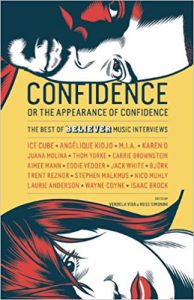Confidence, or the Appearance of Confidence: The Best of Believer Music Interviews, edited by Vendela Vida and Ross Simonini
Confidence or the Appearance of Confidence: The Best of Believer Music Interviews
Edited By Vendela Vida and Ross Simonini
Believer Books
Five Stars
Reviewed by Jessica Gribble
When writers talk to musicians about music, there’s great potential for teasing out thoughts about life’s big questions. In Confidence or the Appearance of Confidence: The Best of Believer Music Interviews, we get to know the writers almost as well as the musicians; it’s wonderful to have such talented and thoughtful interviewers asking much better questions than most fans and newsmagazines. The music connoisseur will recognize most of the artists here, but the book doesn’t suffer if you’ve heard of only a handful. What you quickly find out, after reading a little bit of the first interview (Jack White talking to Dave Eggers), is that musicians are people too.
When Jim Roll (a songwriter and recording artist from Michigan) interviews Björk, he looks down at his notepad to see the words “Talk slow. Listen. Breathe!” But by the time he asks her if the rhythm of her lifestyle works for her, he’s obviously forgotten that he’s talking to one of his heroes. Björk tells him that “…in a way it is a service-oriented job [being a musician]. At the core, making music is all about generosity, and knowing yourself and knowing where you can be at your most generous at any given point. As much as it sounds like it would be selfish and self-indulgent, it is actually the opposite as well. I suppose that’s like any job, at the end of the day.”
The rest of the interviews support this point, that music is a job and musicians are regular old people—except they also show us that being a musician, especially a famous one, means your life is constantly being studied, discussed, emulated, even mocked. We meet musicians from many genres, including Karen O, Carrie Brownstein, M.I.A., Aimee Mann, Ice Cube, Agélique Kidjo, Juana Molina, Thom Yorke, Lady Saw, Alan Bishop, Genesis P-Orridge, and Bun B.
Some of the big questions asked:
• “I’m interested in this idea of contrariness and whether happiness is the enemy of art.”
• “Do you see motivation as a big part of your role?”
• “Returning each time, do you find things disappearing out from under you due to encroaching globalization and the homogenizing effects of monoculture?”
And little questions:
• “Are you against following recipes?”
• “By the way, what did you study in college?”
• “And you wrote the music and the lyrics?”
And personal questions:
• “I’m curious to know how you negotiate shyness. Are you shy?”
• “You’ve attracted some criticism for making some songs that don’t uplift women but degrade them. What’s your response?”
• “What’s the difference between pandrogeny and transvestism or transgender?”
• “John Coltrane was a formative influence. Do you remember meeting him?”
• “Are car accidents a regular occurrence in your life?”
One of the major treats of this anthology is the introductory materials for each chapter. Every essay begins with a quote uttered by the musician during the interview, a list of odd/funny/fascinating bits that came out, and a short paragraph or two to set the stage for the forthcoming conversation. If you read nothing but those materials, you’d thoroughly enjoy yourself—but they leave you eager to know what on earth happened during the interview (for instance) that led to Eddie Vedder describing “places, and what they were not:
• California suburbs: the San Diego punk scene
• London: Mars
• Hershey, Pennsylvania: appreciative of political commentary.”
In short, this is a great book if you like music, musicians, interviews, good writing, finding out how musicians think, finding out how writers think, or learning how to cook tilapia simmered in coconut-cumin sauce.
